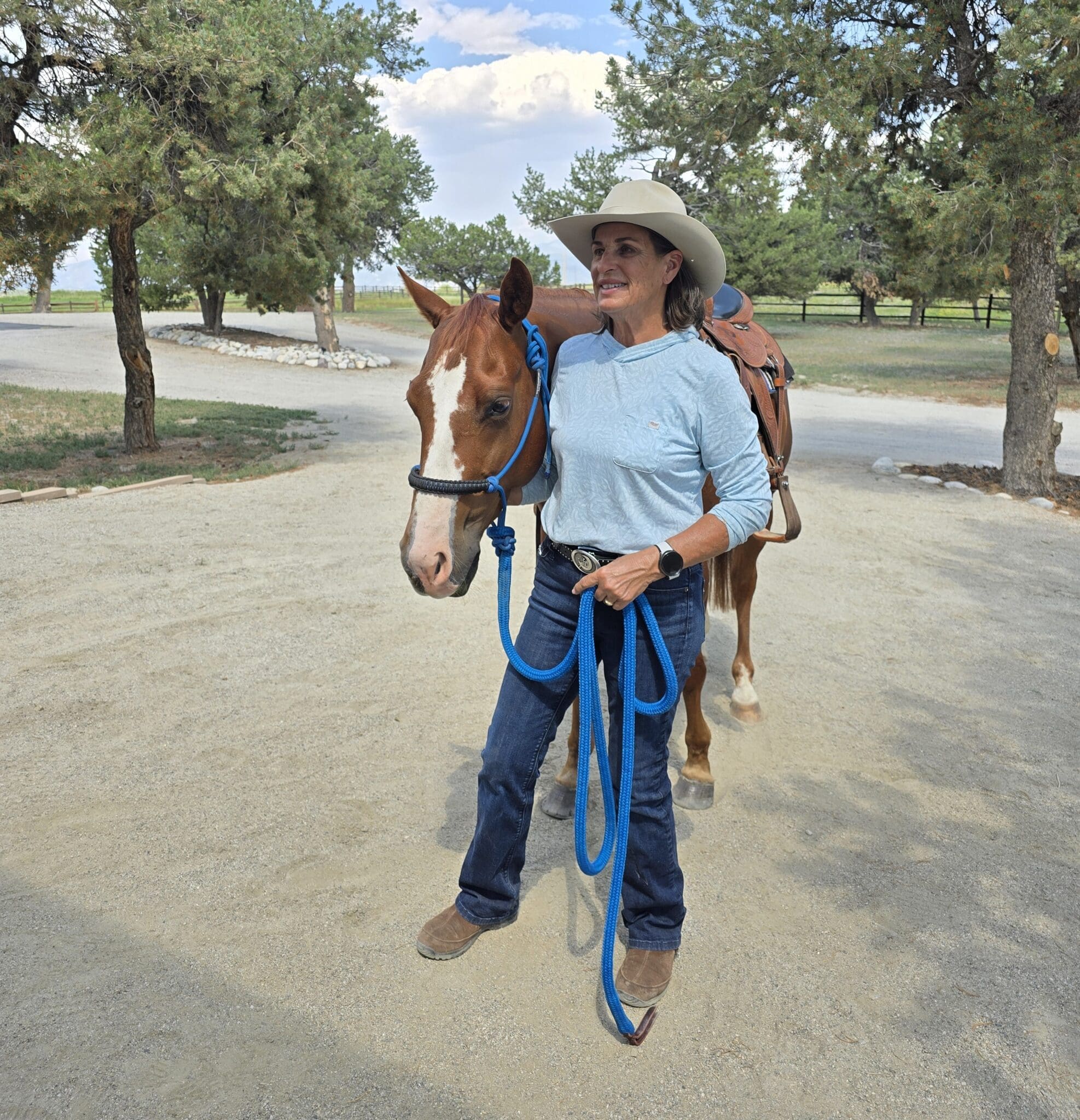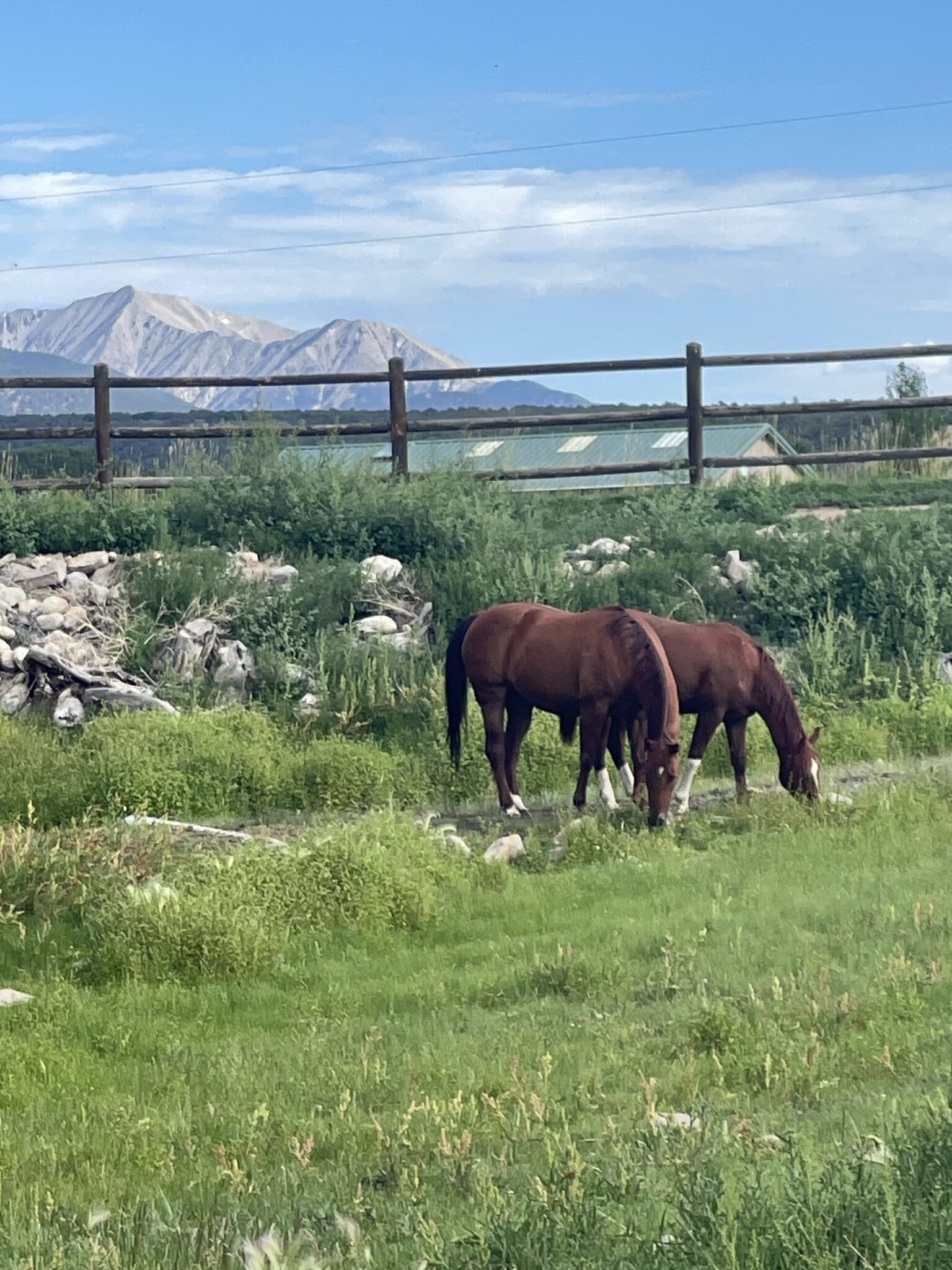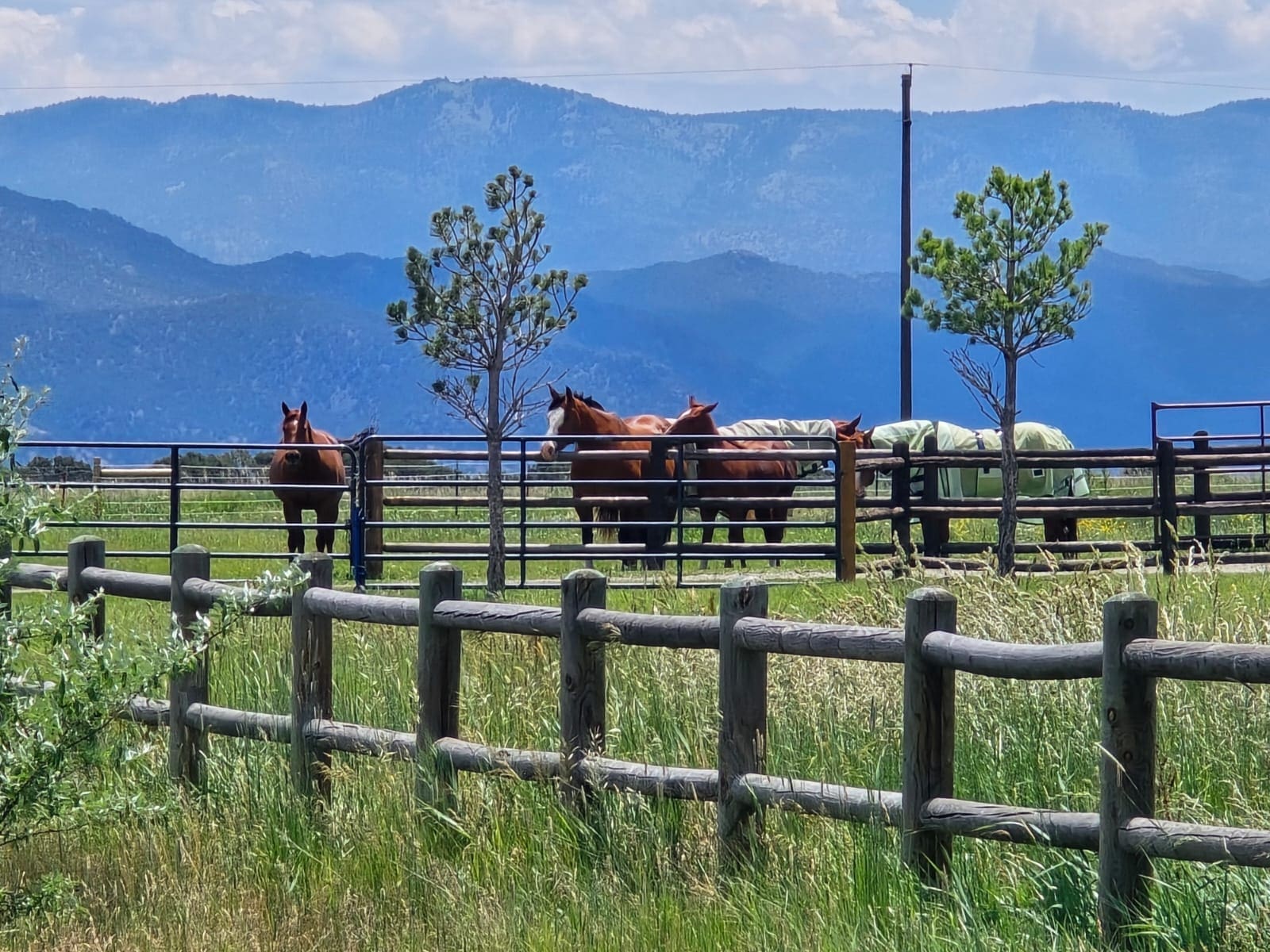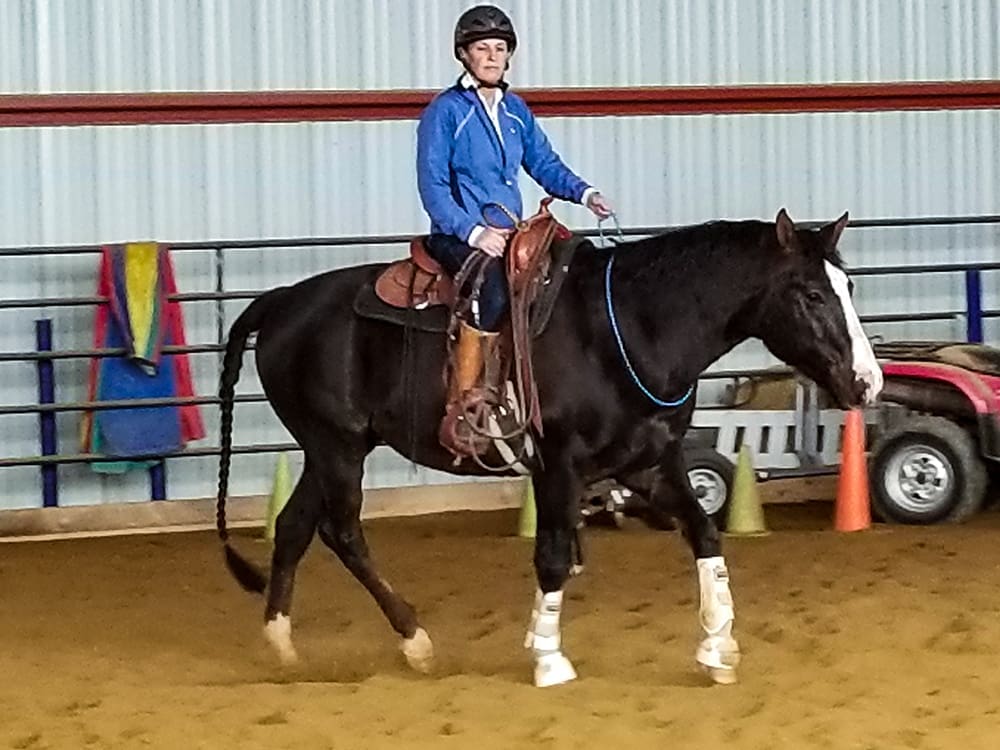Starting last week, new episodes of Horse Master airing for the next nine weeks, which were filmed in Queen Creek Arizona back in January. As usual, I was happy with how all the episodes turned out, but at our “wrap party,” at the end of a long week of taping shows, we always vote on which were the best episodes and brainstorm what the titles should be. The whole crew agreed that one episode really stood out and as we pondered the titles, we dubbed this one “Bucket List.”
The show featured a beautiful blue roan QH mare named Lady, who belonged to a vivacious, delightful and camera friendly woman named Cynthia. She introduced the show with a sad but inspiring story about the death of one of her closest friends, who had made Cynthia realize that life is too short and that she needed to make the most of it and follow her dreams. It wasn’t long before Cynthia went horse shopping and found her dream horse, Lady.
Lady and Cynthia had been together for some time when we met for the shoot and Lady was everything Cynthia had hoped for in a horse except that she was a “star gazer.” For years she had been riding totally inverted and staring up at the sky, to the point that the underside of her neck muscles were bulging the wrong way and her gaits had turned rough and choppy. Otherwise, she was all Cynthia had ever hoped for in a horse: beautiful, well tempered and willing.
I knew right away that changing the bit would have a big impact on the mare, and it did, but I was concerned that after nearly a decade of being ridden in that inverted frame that she would be difficult to re-habituate—both physically and mentally, especially within the strict time constraints of a half-hour TV show. Our viewers are often surprised to learn that pretty much everything that we do with the horse appears on the TV show. I guess they assume that since we could work the horse “behind the scenes” that we do.
But the honest to god truth is that we try our best to show everything that happened with the horse. Sometimes it takes a little longer to get the needed response from the horse than the allotted time for that segment. We always film the training part from start to ‘finish’ (the part where I get on the horse to retrain and/or show the owner what to do) and if it takes longer to get the response I want from the horse than the segment allows, that segment gets edited into a “montage” which shows that some time has elapsed and shows the progression of the horse. Plus I usually mention in the narrative that I have spent about 20 minutes up to now, or whatever time has transpired (the record was 1 hour 40 minutes to get the horse we were working with to walk across the tarp).
In the case of Lady, I changed the bit to something more conducive to training and then started riding her to teach her to lower her head and round her frame. The technique is simple—just apply pressure to the bit when her head is up and release the pressure when her head moves down. The key ingredient is good timing—an expedient release as soon as the head begins to move down.
Keep in mind that I have done this a lot in my career—get on a horse with a high headset and teach him to lower it—and in most cases, I can get the response I want in just a few moments. But Lady took a lot longer than normal; it was 15-20 minutes of working with her before she figured it out (which isn’t very long but the segment only allows me about five minutes for the training part). She was trying hard and not fighting me at all, but after a decade of riding this way, she just really didn’t know what to do. Muscle memory is huge.
After what seemed like a long time, with the camera running and all of the crew and Cynthia watching silently, Lady at first tentatively dropped her head and realized that it got her the release she had been looking for. It was like a light bulb finally went off in her head and from that moment forward, she dropped her lead low, rounded her frame and looked like a show horse. Her gaits became surprisingly smooth and as I looked up at Cynthia to see if she recognized the progress, I saw a big grin on her face and tears streaming from her eyes.
The next step in the episode (and in real life) is to see if the owner can have the same success that I had and this is the trickiest part. Horse Master is not about me coming in and showing how it’s done; it’s about getting the rider to do it. Our show has always been about every rider mastering the skills they need to become their own horse master. Lots of trainers could have the same success I had with this mare but if I can get the rider to understand and enact change, then I feel like I have really accomplished something. And Cynthia did not disappoint me!
Even though it took a while to get Lady to understand what I was asking of her, once she got it, she had it. And when Cynthia mounted to give it a try, it wasn’t long before she got the same response from Lady that I had. It was a beautiful sight to see and Cynthia was no less than thrilled at their progress. After the training/teaching segment, the rider has about 24 hours to get in a few practice sessions, under the supervision and guidance of my trusted assistant trainer. Then we film the closing segment the next day, hoping to see huge progress, and once again, Cynthia and Lady did not disappoint us.
In the closing segment, you can see that Lady looks awesome—her head is low, her trot is slow and collected and together they look fluid and in total harmony. With Cynthia’s closing remarks about how thrilled she was that her horse was now everything she had ever dreamed of, there was not a dry eye to be seen on the crew. We were all so happy for her and so pleased to see her lovely mare in a much happier and comfortable state. I just knew they were destined for great things, but sadly, I was wrong.
A week after the shoot we received the horrifying news that Lady had succumbed to a violent bout of colic and in the end she had lost the battle. Cynthia’s dream horse is now gone forever and she only has happy memories of her now. Sometimes it seems like this only happens to the best horses. Why is that?
Needless to say, Cynthia has been devastated by the loss of her lovely mare and I know that many of you, like me, know all too well the pain and heartaches of seeing a horse die of colic. It leaves a scar on your heart along with the feeling that you’ll never have a great horse again. It’s hard to even think about another horse.
Many old-time horsemen will say that you’ll only be blessed with one really good horse in your lifetime, but I don’t believe it. Currently, I have my fourth “best horse of a lifetime.” The first was my first horse—a trusted Morgan mare named Mini that I had from birth to 14, when she died of old age. The second was my first real show horse, George. He was a push-button Thoroughbred show hunter that carried me to the winner’s circle many, many times. My third best-horse-of-a-lifetime was Pepsea, another Morgan mare, drop-dead gorgeous, who would go anywhere and do anything. She’s still alive but semi-retired. And maybe the best of all is my horse Dually, my current “best horse” who is my partner and friend and who has taught me a lot. He had a near-death experience with colic last fall and we thought we would lose him, but I got to keep him. For now. And I count every day with him as a gift.
I heard from Cynthia after her episode aired last week; nearly three months after she lost her lovely mare. The hole in her heart is slowly healing and although it was previously inconceivable, she now is beginning to think about another horse. Cynthia wrote, “Yes, seeing our episode was bittersweet. I loved seeing us together again and the work you did with her. I have such wonderful memories of the shoot. I can’t thank you enough for this experience because the great memories and the wonderful episode are priceless to me. Also wanted to share that I have heard nothing but great comments from my circle of horsewomen friends about the show and they are a tough sell. Am thinking possibly another month or so and I will start shopping for my next “great horse” and with some luck I’ll find her. I’ll make sure that I share that good news with you when I take that step.”
And I will make sure I share it with you, my readers. In the meantime, I know Cynthia would love to hear your thoughts and comments and encouragement—you can do that here. The moral of the story is to make the most of each day because we never know what tomorrow will bring. When I get home, I am headed out to the barn to hug my horse
Join Julie’s Library Membership to access all of the Horse Master Episodes



